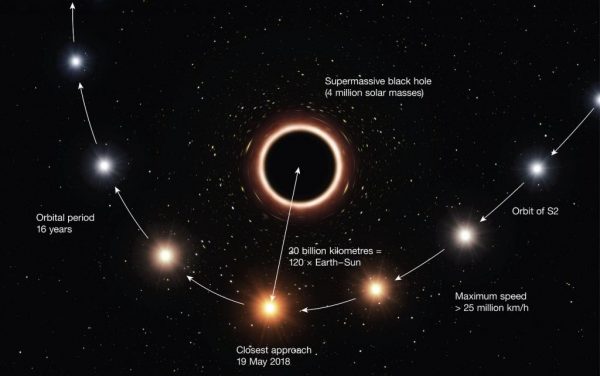A Star is Orbiting the Milky Way’s Black Hole and Moving Exactly How Einstein Predicted it Should – Universe Today
At the center of our galaxy, roughly 26,000 light-years from Earth, is the Supermassive Black Hole (SMBH) known as Sagittarius A*. The powerful gravity of this object and the dense cluster of stars around it provide astronomers with a unique environment for testing physics under the most extreme conditions. In particular, it offers them a chance to test Einstein’s Theory of General Relativity (GR).
For example, in the past thirty years, astronomers have been observing a star in the vicinity of Sagittarius A* (S2) to see if its orbit conforms to what is predicted by General Relativity. Recent observations made with the ESO’s Very Large Telescope (VLT) have completed an observation campaign that confirmed that the star’s orbit is rosette-shaped, once again proving that Einstein theory was right on the money!
The study that describes the international team’s findings recently appeared in the journal Astronomy & Astrophysics. The team responsible was made up of members of the GRAVITY Collaboration, which includes researchers from the European Southern Observatory (ESO), the Max Planck Institute for Extraterrestrial Physics (MPE), the Max Planck Institute for Astronomy (MPA), CERN, and multiple institutes and universities.
To break it down, General Relativity states that the curvature of space-time is altered in the presence of a massive object. When Einstein formalized this theory by 1915, it explained a number of things, not the least of which was the strange orbit of Mercury. By the early 20th century, astronomers had noted that the perihelion of Mercury was subject to precession – i.e. it rotated over time.
Most stars and planets have elliptical orbits, which means that their distance to the object they’re orbiting changes. But in the case of precession, the closest point in their orbit (perihelion) rotates around the object itself. This is known as a Schwarzschild precession which (when visualized) looks like a rosette instead of an ellipse, with each individual orbit resembling a petal of the flower.
As Reinhard Genzel, the director of the MPE and the architect of the nearly 30-year-long program that led to this result, explained in a recent ESO press release:
“Einstein’s General Relativity predicts that bound orbits of one object around another are not closed, as in Newtonian Gravity, but precess forwards in the plane of motion. This famous effect — first seen in the orbit of the planet Mercury around the Sun — was the first evidence in favour of General Relativity. One hundred years later we have now detected the same effect in the motion of a star orbiting the compact radio source Sagittarius A* at the centre of the Milky Way. This observational breakthrough strengthens the evidence that Sagittarius A* must be a supermassive black hole of 4 million times the mass of the Sun.”

In the case of S2, its orbit takes it from a distance of less than 20 billion km (12.4 billion mi), or one hundred and twenty times the distance between the Sun and Earth – making it one of the closest stars ever found in orbit around Sagittarius A*. At its closest approach, S2 is hurtling through space at almost 3% of the speed of light, completing an orbit once every 16 years. This long orbit is why it was necessary to monitor the star for nearly thirty years.
In so doing, the GRAVITY Collaboration was able to see a Schwarzschild precession around an SMBH for the very first time. Said Stefan Gillessen, an MPE researcher who led the analysis of the team’s measurements: “After following the star in its orbit for over two and a half decades, our exquisite measurements robustly detect S2’s Schwarzschild precession in its path around Sagittarius A*.”
These results confirm General Relativity, which accurately predicts how much the orbit of S2 should change over time. The study with the VLT is also a boon for astronomers because it allows them to learn more about what is taking place in the vicinity of Sagittarius A*, which could shed light on the evolution of our galaxy and other cosmological mysteries. Said Guy Perrin and Karine Perraut, the French lead scientists of the project:
“Because the S2 measurements follow General Relativity so well, we can set stringent limits on how much invisible material, such as distributed dark matter or possible smaller black holes, is present around Sagittarius A*. This is of great interest for understanding the formation and evolution of supermassive black holes.”
These findings are the result of 27 years of observations of S2 that (for the majority of that time) relied on a fleet of instruments at the ESO’s VLT. These included the GRAVITY, Spectrograph for INtegral Field Observations in the Near Infrared (SINFONI), and the Nasmyth Adaptive Optics System (NAOS) – Near-Infrared Imager and Spectrograph (NACO), which together took over 330 measurements of the star’s position and velocity.
The GRAVITY Collaboration is named after the instrument they developed for the VLT Interferometer, which combines the light of all four 8-m (26.25 ft) VLT telescopes into a super-telescope with a resolution equivalent to that of a 130-m (426.5 ft) telescope. This same team was responsible for the 2018 study that confirmed General Relativity by showing how light from S2 was stretched to longer wavelengths when passing close to Sagittarius A*.
Looking ahead, the team believes that they will be able to see much fainter stars orbiting Sagittarius A* using the Extremely Large Telescope (ELT). Andreas Eckart, a researcher from Cologne University and one of the lead scientists of the project, believes that they will be able to measure the spin and mass of Sagittarius A*, thus characterizing it and defining the nature of space-time around it.
“If we are lucky, we might capture stars close enough that they actually feel the rotation, the spin, of the black hole,” he said. “That would be again a completely different level of testing relativity.”
Further Reading: ESO, Astronomy and Astrophysics






